About Photovoltaics
How does solar energy work?
Solar energy is possible because of electrical conductivity that occurs when visible light, or photons, touch a specific type of material: silicon. When silicon is treated with certain other elements like phosphorus or boron, it will end up with either one extra or one less electron available for conducting electricity. If a silicon with an extra electron (called N-type) is placed next to a silicon with one less electron (P-type), there is a potential for electrical transmission.
When sunlight hits the silicon it energizes it and the electrons travel from one type of silicon to the other, and the entire collection of solar cells becomes like a giant DC battery conducting electrons in one direction. By placing thin wafers of silicon in a wide panel formation to gather a lot of sunlight and encasing it in protective materials like aluminum, tempered glass, and plastic insulation, those thin silicon wafers become a solar panel, technically known as a solar module.
How do grid-tied systems work?
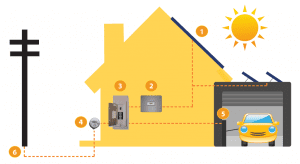
- Solar panels are typically installed on the roof of the home and/or garage. These photovoltaic (PV) solar cells convert sunlight into direct current (DC) power.
- The inverter(s) converts DC electricity from the solar array to the AC electricity found in the building.
- The inverter feeds electricity into the electrical distribution system (ie. electrical panel).
- The bi-directional meter (supplied free of charge by the utility) keeps track of both the energy imported from the grid and the energy exported to the grid. Savings and export credits are reflected on your electricity bill.
- If you own an electric car, you can charge it up with solar power generated on your own home.
- Your home remains connected to the utility grid to supply you with electricity when you need more power than your system is producing, such as at night.
Commercial grid tied solar electric systems.
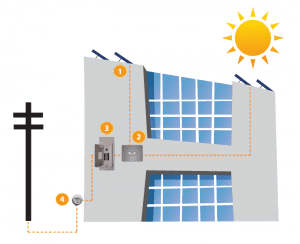
- Photovoltaic (PV) modules convert sunlight into direct current (DC) power.
- The inverter(s) convert DC electricity from the solar array to the AC electricity found in the building.
- The inverter feeds electricity into the electrical distribution system.
- The bidirectional meter (supplied free of charge by the utility) keeps track of both the energy imported from the grid and the energy exported to the grid. Savings and export credits are reflected on your electricity bill.
Solar Power System Cost and Savings
How much does a solar power system cost?
A typical residential solar array can cost anywhere from $10,000 to $30,000 and beyond, but the entire process is custom designed and varies for every customer, business or family. The factors that impact the cost of a solar PV system, generally, are your typical electricity consumption, the age and design of your home or building, and your goals in terms of electrical energy production.
Factors like the mounting space, potential battery storage, a customer’s electricity production goals, and the complexity of the work required in the attic and\or mechanical room all play into the final cost of a solar array for your home and business. Our solar specialists and sales staff are equipped to provide some baseline estimates and information at any time, so contact us to start the consultation process.
Commercial solar systems have a much higher variability of cost. While a small business’ solar array could theoretically be similar in price to a residential system, there are more factors involved in those cost estimations. Contact one of our Solar Specialists directly to determine possible costs for your business to go solar.
How much money will I save on my electricity bill each month?
The answer to this depends on two factors: how much sunlight your solar photovoltaic (PV) system receives, and how much electricity your household or business uses. In late spring and summer, your solar system will generate more electricity than the fall and winter, and reduce the amount of electricity you need to pull from the grid. This is because the sun is higher in the sky and is out for more hours of the day.
If your grid tied solar system is designed to offset 100% of your annual electricity usage, during months of greater sun exposure you will receive credit on your utility bill. Those credits, which vary slightly from province to province, will build up in months when your solar generation exceeds your monthly usage. Those credits will apply to your utility bills in the fall and winter, which is how your solar system can continue to financially benefit you even in months of lower sun exposure.
If your grid tied solar system is designed to offset only a portion of your home or business’ annual electricity usage, you may not notice as much direct credit on your utility bills, if any. Your solar system is still performing and saving you money, however. The solar system is directly feeding your electrical panel while the sun is shining, which means that the circuits in your home or business are receiving electricity from your solar system as well as the grid. Since you require less grid energy to power your home or business, your grid demand in kWh will be reduced. These savings are technically “invisible” on your utility bill, since you are simply reducing your grid demand, but you can still track your solar system’s production through the monitoring app we provide you.
Please note that while your grid tied solar system will produce its maximum electricity output in the late spring and summer, your utility bill will still reflect some kWh of electricity usage from any energy used over the night time. In larger systems, your credits from excess electricity sold to the grid during the day should offset this, but do not expect to have zero grid energy consumption during these months, even if your bill is much lower.
Regardless, if you are connected to a utility, you will be charged transmission and distribution fees. The only way to avoid those fees would be to design an entirely off grid, battery powered system using a Tesla Powerwall or custom battery storage system. This is possible, though expensive.
Am I selling electricity back to the grid?
Yes. If your solar system has more capacity than your home or business’ demand, you will receive credit from your utility during the late spring and summer, though the details vary slightly between jurisdictions.
In Alberta, the Micro-Generation Regulation states that every electrical retailer must purchase a building’s excess solar energy exported to the grid through a two way meter. The Regulation further states that micro-generators must be compensated at the “rate the service provider charged the micro-generator for electric energy supplied to the micro-generation site”, which means the same retail rate you pay. Using Alberta’s net-billing framework, your exported energy is saved as a credit on your account and used to reduce your bill during lower production months.
In British Columbia, most jurisdictions follow a net-metering framework. The net metering framework used by FortisBC incorporates a meter that has two displays: one to show the kilowatt-hours (kWh) delivered to your home or business and one to show the kWh of generated electricity from your PV system. If you generate more electricity than you can use in one billing period, the excess is banked and can be used in a future billing period. With net-metering, if you produce more than you consume on an annual basis you will be paid out for the remaining kWh in your bank at the wholesale rate.
In the City of Penticton, any energy put back into the Utility system will be credited back to the customer at the existing FortisBC wholesale rate each billing period.
In a building on the BCHydro distribution infrastructure, excess generation is credited on each bill. If there is still generation credit on the anniversary date of joining the program, BC Hydro will pay the credits at a rate of 9.99 cents/kWh.
If your home or business is on a different electrical utility, please contact your Solar Specialist for more information.
Will my electricity bill look different with a solar system installed?
Yes, though only slightly. All of the same information will still be on your electricity bill in terms of usage and transmission fees. There will be an additional line item, however, to reflect the potential credits from your excess solar electricity, as determined by your utility owner’s policy.
Solar System Battery Back-Up
Do I need batteries for my solar system?
No. Though battery backup systems like the Tesla Powerwall are becoming more popular, such systems are not required in order to harness solar energy. Grid tied solar PV systems are designed to interact with large electrical distribution systems and provide electricity in real time as it is produced.
Rather than being stored in an on site battery system like the Powerwall, the electrical grid itself serves as a kind of informal battery, since PV systems feed energy into it when they are producing more than you need, and you can still pull electricity from the grid at any time on demand.
My solar system was designed with battery backup, what difference will this make on my bill or otherwise.
Battery backup systems such as the Tesla Powerwall provide several advantages however the two main advantages are even further reductions in electricity demand, and continuous power in the event of a power failure.
A battery backup further reduces your electricity consumption because stored excess electrical energy from the day time can be used throughout the evening and night times. In months with significant solar energy production, you could potentially have zero grid energy demand in kWh, if you have sufficient storage to power your home or business through the evening. This is all dependent on your home’s electricity demand, however.
With a Tesla Powerwall or a purpose built battery backup designed by SkyFire Energy, you will experience no interruption of electricity in the event of a power failure. There are safety mechanisms built into those systems to switch your home’s electrical service to draw power strictly from the batteries or Powerwall in the event of such a failure.
Solar System Monitoring
How do I know what my solar system is producing?
Production monitoring is a standard feature of solar energy systems. If you can provide our installers with access to your home or business’ internet connection, your solar system’s production data can be sent to the cloud so you can access it on a computer or smartphone at any time. The data is provided in nearly real time, with only a 5 to 10 minute delay, so that you can see how much electricity you are producing. If there is any kind of technical issue with your solar system, the monitoring system allows both you and SkyFire to see it, allowing for much easier diagnosis and solution.
Do I still have electricity if the power goes out?
The majority of solar systems installed today are called grid-tied systems. This means they are directly connected to your home’s electrical distribution panel, and therefore to the larger grid beyond.
Since your solar panels are a source of electricity, grid-tied systems require the panels to be disconnected from the grid in the event of a power failure. This is done to ensure the safety of the workers fixing the grid distribution system, since if the solar panels were still connected those workers would be injured by it.
As such, grid tied systems do not function during a power outage.
That said, with the right equipment and installation, you can design a system that will stay functional in the event of a power outage. Such a system would be more expensive, in terms of design and cost of materials, but with a custom battery storage system or a Tesla Powerwall, you could be independent of the grid.
Government Incentives
Are there any government incentives available?
ALBERTA
Currently, small Micro Generation producers in Alberta will automatically receive a credit which is equivalent to their current electricity rate, for surplus electricity generated and exported to the grid. For instance, if you are currently paying 8 cents/kWh for your electricity, you will also receive 8 cents/kWh for any excess solar energy that is fed back to the grid from your PV system. The bi-directional meter which is supplied free of charge by your Wire Services Provider keeps track of both the energy imported from the grid and the energy exported to the grid. These meter reads are processed on a monthly basis and any excess solar energy supplied to the grid will show up as a credit on your monthly electricity bill. Terms of reference are defined within the Alberta Micro-generation Regulation. Furthermore, if you decide to sign up as a SPARK Certified Green Generator, you could receive 1.85 ¢/kWh for the renewable energy attributes of your exported energy, in addition to the credit that micro-generators currently receive for the sale of their exported electricity. For more information about the SPARK Green Offset Program and how to sign up as a SPARK Certified Green Generator, please click here.
Alberta Residential and Commercial Solar Program – Please note funding for this program has been discontinued.
Alberta Municipal Solar Program
The Alberta Municipal Solar Program will provide rebates of up to $0.90 per watt to municipalities for installing solar on municipal buildings, such as offices, fire halls, community centers and more. Projects up to 5MW of installed capacity will receive the full AMSP rebate. The rebate provided by the MCCAC will not exceed 30% of eligible expenses. The Alberta Municipal Solar Program started accepting applications on March 1, 2016.
On-Farm Solar Photovoltaics Program – Please note funding for this program is on hold.
The On-Farm Solar Photovoltaics Program provides funding towards solar photovoltaics on Alberta farms. This enables producers to conserve non-renewable fossil fuels and reduce carbon emissions, ultimately reducing the environmental footprint of Alberta’s agriculture industry. The Solar Photovoltaics Program addresses two important industry priorities: 1) Improved environmental stewardship. When producers make investments in clean energy and reduced carbon emissions, they are recognized for their commitment to sustainable practices. 2) Improved energy management. Producers who install photovoltaic systems tend to take a renewed interest in their electricity usage; this leads to additional efficiency investments.
Banff Solar PV Incentive Program
The Town of Banff Solar PV Incentive Program is a post-install rebate program, with funding based on the size of the solar system installed. Eligible participants install a solar PV system on their home or business, and then receive a financial rebate from the Town, based on the size of the solar system installed. The Town provides eligible participants with a rebate of $750/kilowatt (kW) of solar capacity installed, to a maximum of 7.5 kW. Click here for more information.
Canmore Solar PV Incentive Program
A limited number of solar incentives of $1,250 are available to residents and businesses to help offset the cost of purchasing and installing a solar electric system in Canmore. Eight incentives are available and drawn by lottery. The application process is closed for 20189 but will resume in 2020. All projects must meet building and electrical safety code requirements, and the minimum installation requirement is a 2.5kW solar electric system. Click here for more information.
Medicine Hat Solar PV Incentive Program
The Solar Electric Incentive Program (the Program) offers rebates to residential utility customers to purchase and install solar PV systems on their homes. The rebate amount is awarded based on the size of the installed system. For more information visit the City of Medicine Hat.
Edmonton Solar PV Incentive Program
The City of Edmonton is currently offering an incentive of $0.40/watt towards the cost of installing a residential system. Click here for more information.
Brazeau County Solar PV Incentive Program
REBATE = $0.90/WATT (UP TO $10,000) Only one application per landowner within the County as a whole. Further applications may be considered in future program initiatives. For residential service, the solar photovoltaic (PV) system must be grid-connected in accordance with Alberta’s Micro-generation Regulation (AR27/2008). The system must not be eligible for the Alberta Municipal Solar Program (AMSP) or the Alberta Indigenous Solar Program. Click here for more information.
Solar for Schools Program
The Solar for Schools (SFS) Program provides financial rebates to Alberta Public School Authorities who install solar photovoltaic (PV) systems on existing school facilities or land in their jurisdiction and complete a student education initiative as part of the project. For detailed information on eligibility requirements, available funding, and how to apply, please refer to the Municipal Climate Change Action Centre.
Equs Solar Preferred Supplier Program
Through a Request for Proposals process, EQUS has selected SkyFire Energy as the preferred solar supplier. This is to help easily connect EQUS members who are interested in becoming micro-generators with a reputable contractor to supply and install a solar system for them. It also provides a streamlined process from start to finish, helping make the application and installation process as smooth as possible. For more information visit the Equs Website.
NORTHWEST TERRITORIES
The Arctic Energy Alliance (AEA) is currently offering the following energy efficiency incentive program:
Residential Renewable Energy Fund (RREF) The Residential Renewable Energy Fund is part of the Alternative Energy Technologies Program (AETP) offered through the AEA. Through this program, NWT residents can receive a rebate on the purchase of any renewable energy generation system.
Residents are eligible for up to $20,000 in rebate funding. and businesses, community governments, Indigenous governments, and non-profit organizations are eligible for up to $50,000.
The rebate amount you receive will be the lower of:
50% of the total eligible costs of your project
A calculation based on the amount of money and greenhouses gases that your project will save (see the program guidelines for more information)
Apart from solar photovoltaic systems, the rebate can also be applied towards wind turbines, ground-source heat pumps, Solar thermal (hot water and air), hydro, and pellet and wood furnaces. Visit Arctic Energy Alliance for more details.
SASKATCHEWAN
SaskPower Net Metering Program:
System size criteria: Up to 100 kW (dc). This allows you to install a solar PV system which will generate energy to decrease your monthly power bill and receive credits for excess power generated.
You will now receive 7.5 ¢/kWh (instead of the standard retail rate) for any excess power you use and provide back onto the SaskPower power grid.
When you’re using the power your system produces, you’re offsetting power from the grid at your standard retail rate (e.g. 14.54¢/kWh for residential customers in 2019).
You can carry forward any unused credits on your bill until you move or close your account. Please note that the credits are non-refundable and will not be paid out.
More information here.
BRITISH COLUMBIA
Summerland Net Metering Program:
The District of Summerland has relaunched its Distributed Generation (Net Metering) Program! This program allows customers with small (30kW or less), inverter-based, distributed generation (DG) solar PV systems or wind turbines to be connected to the Summerland Distribution System (Summerland’s electric grid).
Summerland electrical utility customers who participate in the program are able to completely offset their own electricity needs each calendar year, after which the District of Summerland will purchase any excess energy that is put back onto the grid at the wholesale rate.
Full details on the program and the current retail rates (under Fees & Charges Bylaw) can be found here.
PST Tax Exemption:
The following materials and equipment are exempt from PST in British Columbia: Solar photovoltaic collector panels, and wiring, controllers, and devices that convert direct current into alternating current, when they are sold with, and as part of, a system that includes solar photovoltaic collector panels. Solar thermal collector panels, and wiring, pumps, tubing, and heat exchangers, when they are sold with, and as part of, a system that includes solar thermal collector panels.
FEDERAL
Section 43.2 Tax Incentives (commercial projects only):
A 50% accelerated CCA is provided under Class 43.2 of Schedule II to the Income Tax Regulations for specified clean energy generation equipment. Eligible equipment includes solar thermal, solar air and solar photovoltaic equipment while project size restrictions have been eliminated. Depreciation of the solar asset can only be applied to solar revenues unless the business is involved in manufacturing or processing, mining or the sale, distribution or production of energy of any kind.
For more information please click here.
Federal Solar Rebate for Small- and Medium-sized Enterprises (SMEs) –the application process is now closed
Keep in mind that incentive programs can change quickly and the information above may not always be completely up to date. Please contact SkyFire Energy for the most up to date information.
Planning
What is involved in a solar site assessment?
A detailed and comprehensive solar site assessment is a necessary component for any solar electric installation. A typical site assessment includes the following:
- Accurate measurements of roof or ground space including locations of plumbing stacks, chimneys, skylights, attic vents, etc
- Shading analysis from the proposed location for solar (sometimes several points need to be analyzed to determine the best location) – this data is used to provide accurate energy production estimates
- Discussion with home or business owner to determine the route of cable from site of the solar electric array to location of inverter/mains panel
- Determine the location of the inverter(s) and integration into the building’s electrical system.
As a first step, SkyFire will provide preliminary ballpark cost, energy production, and an economic analysis specific to your home/building through email. We would be pleased to provide a comprehensive site assessment after this initial step. For new construction residential and commercial projects, SkyFire can provide a design and quote directly from the drawings for the building. – Contact us to get started today!
What is the residential solar installation process like from start to finish?
Making the decision to switch to solar is an awesome one. However, getting started and understanding the process can often be fraught with uncertainty for those unfamiliar with the industry. SkyFire Energy provides turnkey systems and takes care of all of the permitting, grid connection application, etc. Here is a list of the steps for a typical residential installation:
- Initial estimate – If high-quality satellite images are available, we can provide accurate estimates for system size and energy production for your specific house.
- Site assessment – We visit the site to obtain detailed site-specific information required for a solar installation including detailed roof measurements, electrical capacity of your electrical system and a shading analysis (if required). For a new construction home, SkyFire can design a system right from the architectural drawings.
- System design & quote – SkyFire will design a system specific to your roof space, budget and electricity needs. This is an iterative process and multiple options can be presented. SkyFire provides you with a sketch showing what your home will look like with solar on the roof as well as an economic analysis.
- Permitting and grid connection application – SkyFire takes care of ALL the permitting required (Electrical, Building and/or Development permits) and the application to connect the system to the grid.
- Installation and commissioning – by our highly trained and experienced installation crews.
- Final walkthrough with the homeowner and delivery of system manuals

It’s that easy! Contact us today to get started.
How can I build to account for a future solar PV system?
One of the most important considerations is the design and orientation of your roof’s faces. In the Northern hemisphere, south facing solar arrays are the most effective since the sun shines from that direction for the entire day. East and west facing solar panels can still produce significant amounts of electricity, but southern orientations will always yield the most efficiency for your solar dollar.
Large, unobstructed stretches of roof pointing south (or east or west) will lead to a higher concentration of solar modules in the available space, and be easiest for installation crews. One larger collection of modules facing south will be cheaper and faster to install than a collection of east and west facing modules on multiple different roof faces.
Another relevant consideration is an electrical raceway or connection providing access to your home or business’ mechanical room. When we retrofit solar we typically must penetrate the envelope of the building to access the attic, run wiring somewhere on the exterior of the building, and drill into the mechanical room from the outside to gain access. If a building is designed with either an approved conduit or a wire of sufficient ampacity and proper electrical code requirements from the vicinity of the roof directly to the electrical panel, you can create significant cost savings on an installation with relatively minimal investment.
Solar Performance in Canada
How does Canada’s solar potential compare globally?
Canada may not be your top choice for a tropical destination, but luckily for us, warm weather actually has very little to do with our ability to generate solar power! Surprising to many, latitude has only a small effect on solar production. For example, a solar PV system located in Calgary will produce approximately the same amount of energy on an annual basis as that same system in Miami, Florida. Calgary receives lots of sunshine all year round and solar PV modules actually produce more energy when they are cold! Canada also compares extremely well when comparing the production potential of leading solar industry countries. For example, Alberta’s solar resource is significantly better than Germany’s (up to 50% more) despite the Germans leading the solar industry globally!
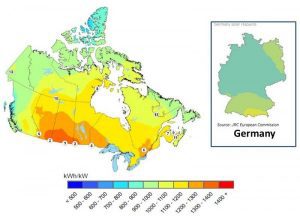
Additionally, Calgary, Edmonton, Regina,Toronto and Vancouver all rank higher in yearly photovoltaic (PV) potential than Berlin. Calgary even has higher solar potential than Rio de Janeiro, Brazil, and Rome, Italy Even remote areas of the Northwest Territories, Nunavut and the Yukon rate high in yearly PV potential. A solar PV system designed and installed by SkyFire in Fort Simpson, NT has produced ~980 kWh/kW in the year since its installation – that’s more than the PV potential of cities such as Tokyo, Paris, and London! These examples illustrate the importance of investment in Canada’s solar energy resource in the years to come. Data and images: CanSIA and Natural Resources Canada
What happens when it snows?
Canadian winters are synonymous with snow so it is important that consideration is given for the effects of snow on winter and year-round energy production from solar electric and solar thermal systems. Although clearing the snow from a solar array can help you squeeze a few more kiloWatt-hours (kWh) from your solar PV system. We do not recommend that any of our customers get up on their roof to clear the solar modules (panels) of snow during the winter months – this is extremely dangerous and not necessary. With a grid-connected solar electric system, the total annual energy production from the system is most important. The majority of the energy produced by a solar electric system in Canada is produced from March to October. Lost energy production due to snow during the darker months of November to February is not as important. With all that said, solar electric and solar thermal systems will actually clear themselves of snow! There are a number of factors that affect when and how quickly this will happen such as:
- ambient temperature – the warmer the better
- amount of sunlight (insolation) – the snow isn’t usually cleared on a cloudy day but the energy production from a cloudy winters day is negligible anyways
- angle and orientation of the solar array – the steeper the angle, the quicker the snow clears; facing directly South or slightly West of South helps with snow clearing
- solar module backing color (dark or black modules will get hotter) – black solar modules might clear snow faster but solar modules actually produce less energy when hot, more when they are cold so there are tradeoffs here
- How much snow is on the modules – the sun can penetrate a couple of inches of snow to heat up the modules but penetrating through 6 inches of snow or more is less likely – a big dump of snow might stick to the modules until the wind blows some of it off or until warmer weather moves in
To help illustrate this point, we recorded a time-lapse video showing the snow clear from our Calgary office’s solar array after a snowstorm blew through. The roughly 6cm of snow was cleared by 2:30 pm the day after the snowstorm.
The solar array, in this case, is at 35 degrees, which is a good angle for year-round production while limiting the ‘sail’ effect and structural concerns of a more upright solar array. This system uses Enphase Energy microinverters which allow for energy monitoring of each individual module. We can see the effect of the snow cover on the bottom of the solar array reflected online. The photo and the monitoring screenshot both show conditions at 1:15 pm the day after the blizzard:
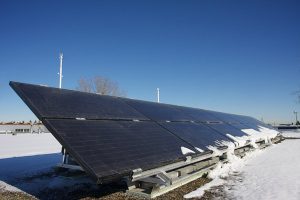
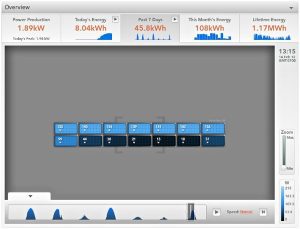
Will my solar panels stand up to hail?
Solar panels are manufacturer rated for impacts from golf ball sized hail and larger. One typical rating is for a 55 mile per hour impact of a one inch diameter hail stone at a 90 degree angle. While extreme weather events can damage panels, the upward facing surfaces are made of tempered glass and are generally facing south if possible, and at an angle that would refract the falling angle of the hailstones.
Solar installations can be added to home insurance policies to protect a homeowner’s investment from damage.
Check out this solar panel hail test video:
How does the angle of a solar array affect performance?
The more perpendicular to the Sun’s rays a solar module is, the greater the output. Having your modules face directly South (Azimuth = 0) and at a 45 degree tilt from the horizontal is ideal in Calgary. As we can see, the overall effect of deviating from the ideal is not altogether significant.
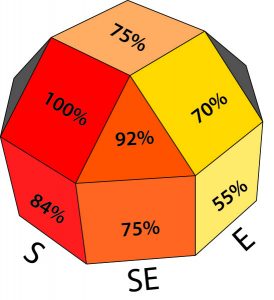
Do I need to clean my solar panels or remove snow?
It’s generally not needed or recommended to clean solar panels or remove snow from them, especially if an array is on a difficult to access or steep roof. In most circumstances, the angle of installation should allow for rain and moisture to clear dust and debris. As well, while snow does have some impact on solar production, since months with snow are typically the worst producing months for solar energy, the danger and effort of climbing onto your roof to remove snow will not pay off very much in terms of money returned.
However, if you notice debris building up on your array and it is not clearing itself after rainfall then an annual cleaning may be worth undertaking. This should be done on cooler cloud covered days with just water and a sponge.
DO NOT use any cleaning chemicals as this can damage the anti-reflective coating on the solar modules. Please note extra cleaning will not increase your energy yield.
Does my solar system still produce electricity when it's cloudy outside?
Yes. The solar modules we install use Passivated Emitter Rear Cell (PERC) technology to enhance production under cloudy conditions. While solar modules generate the most electricity on clear days with abundant sunshine, they will still generate electricity on cloudy days, generally around 10 – 25% of their rated capacity. The exact amount varies depending on the density of the clouds as well as the type of solar module installed. Cloudy days will come and go, but what matters most is how much sunlight you get all year round and there’s plenty of that in sunny Alberta, Saskatchewan and BC.
How long do solar panels last?
Though specific details and numbers depend on manufacturer specifications, a typical solar panel warranty guarantees that it will produce 85% of its rated power production 25 years after it goes into use. Since the conductive material slowly degrades over time, it will still operate, but it will produce less power than it did before.
The majority of solar panels in use today have been in use less than 20 years, which means we will only be getting an accurate picture of solar’s end of life in the coming years. That said, the expectation we generally set for customers is to expect the panels to stay on the roof for 30 to 35 years.
